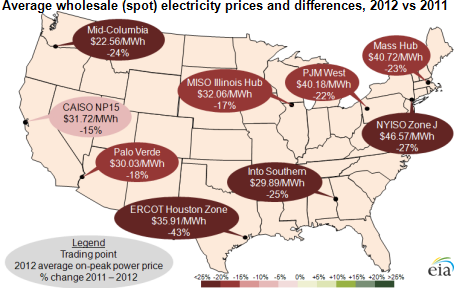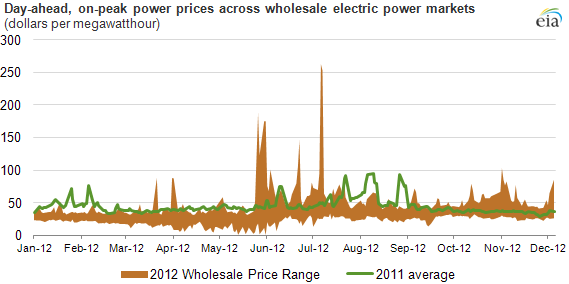
2012 Brief: Average wholesale electricity prices down compared to last year

Note: Click to enlarge.
This article continues a series of briefs on energy market trends in 2012.
Average, on-peak (weekdays from 7:00 a.m. to 11:00 p.m.) day-ahead electricity prices were lower across the entire United States in 2012 compared to 2011. In wholesale electric regions where prices declined in both 2011 and 2012, the drops in 2012 were generally larger. Lower natural gas prices in 2012 and generally mild temperatures contributed to the 2012 declines in on-peak power prices. The large decline in average spot prices in the Electric Reliability Council of Texas (ERCOT) region was principally because of a return to more typical pricing in 2012 compared to the significant price spike in the summer of 2011.
Off-peak (nights and weekends) wholesale electricity prices were also generally lower in 2012 than in 2011, although the decreases were much less dramatic than in on-peak prices. The only regional increases in off-peak prices that occurred between 2011 and 2012 were in California, where the extended outage of the San Onofre Nuclear Generating Station affected the wholesale power supply in that region. Nuclear units typically serve as baseload capacity, running throughout the day and night. The slightly higher off-peak prices reflect the cost of replacing the less-expensive generation from nuclear units.
Although average electricity prices were down in 2012, brief periods of high temperatures caused short-term price spikes in some wholesale electricity markets. A short heat wave in late-June caused price increases in eastern electric systems, while high temperatures in August caused elevated prices in ERCOT. These price patterns are typical market reactions to high temperatures in the summer as electric demand increases to meet air conditioning load.
Power prices in the late fall and early winter of 2012 began to increase across much of the country, also following the trend in natural gas markets. Natural gas prices were consistently falling throughout the latter half of 2011 and into the summer of 2012. Because natural gas generators often set the market-clearing price for electric power, wholesale electric power prices often trend together with natural gas prices.

Note: Data include day-ahead, on-peak prices from Mid-Columbia, CAISO NP-15, CAISO SP-15, Palo Verde, PJM N. Illinois Hub, ERCOT Houston Zone, Entergy, PJM Western Hub, NYISO Zone J, NE-ISO Mass Hub, MISO Illinois Hub, and Into Southern pricing points.
Tags: electricity, generation, map, natural gas, nuclear, prices, spot prices, wholesale prices